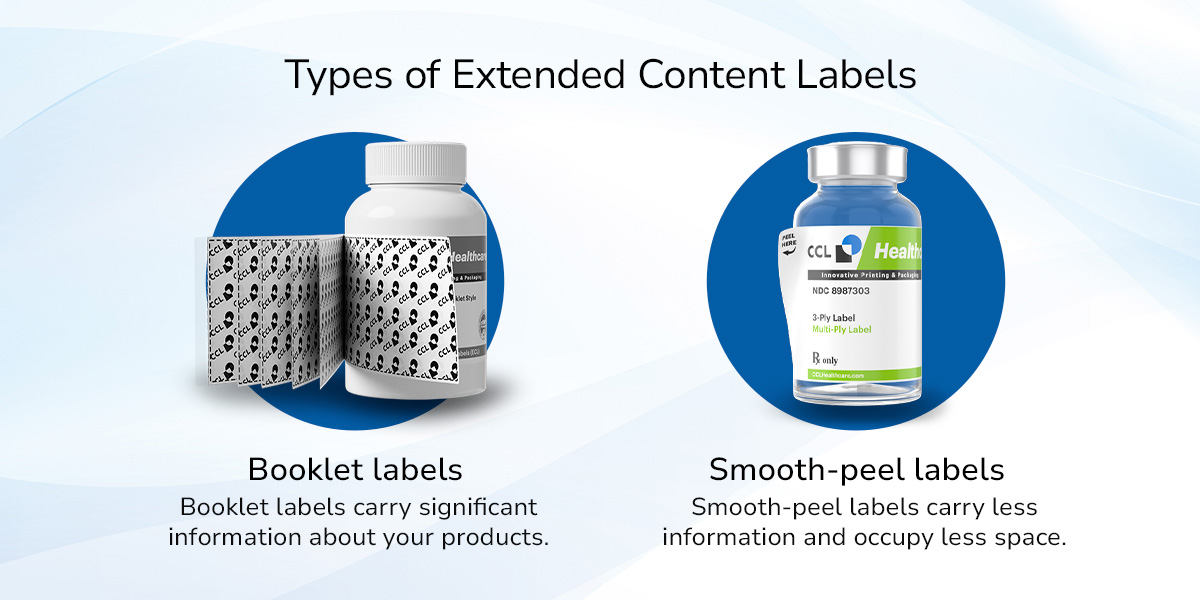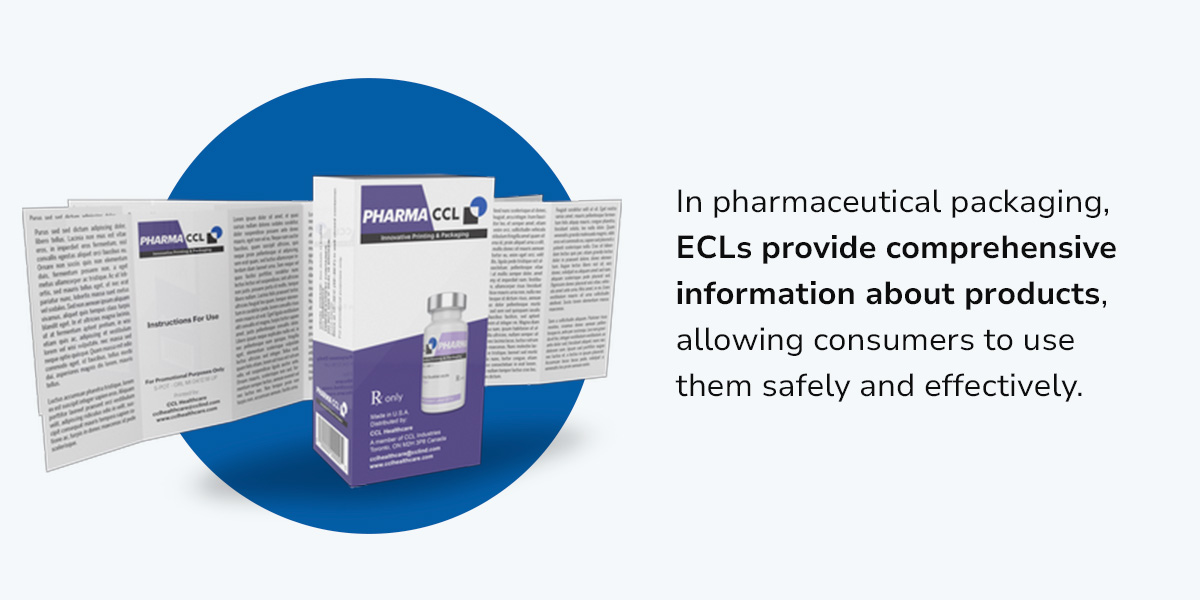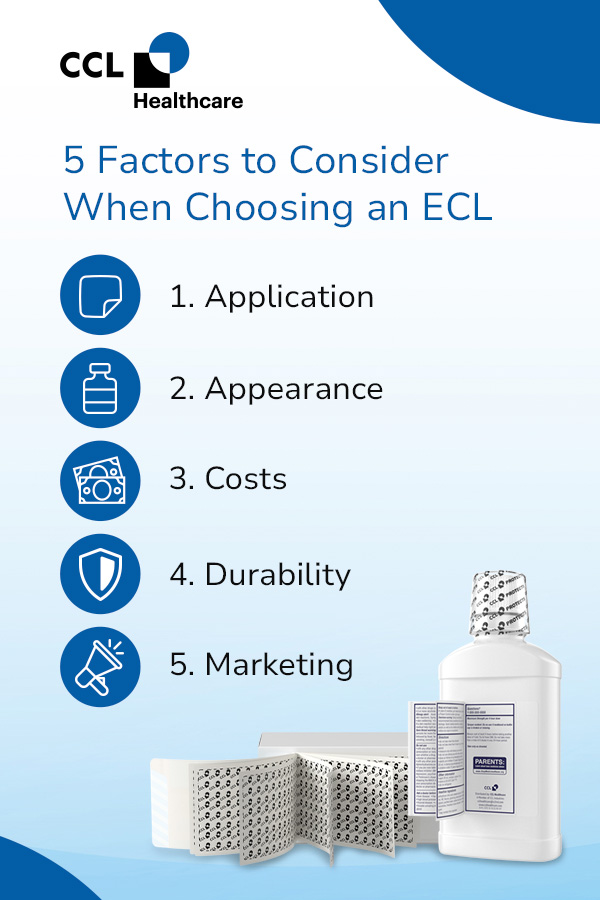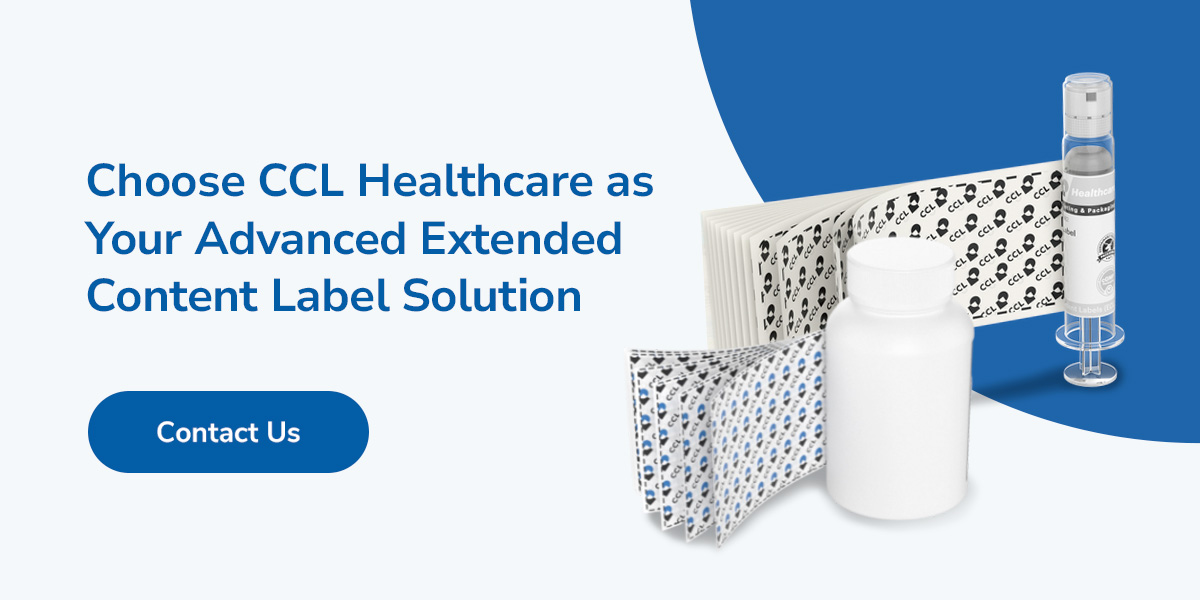Types of Extended Text Labels
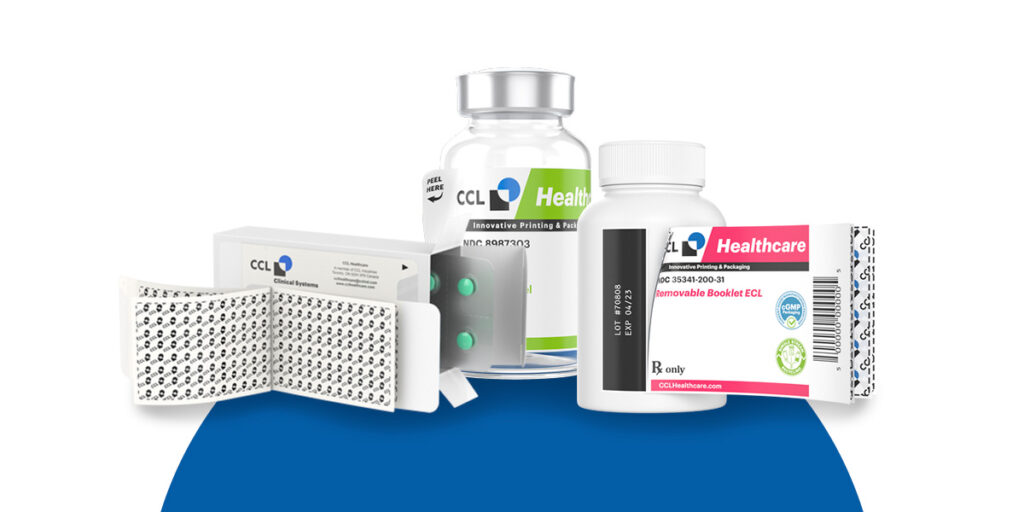
Extended content labels (ECLs) are found on various pharmaceutical products and play a vital role in protecting the safety of your customers. Many products with potentially dangerous substances have these booklet labels, which provide consumers with comprehensive information. Some products also come with complex instructions that need the space only wraparound labels can provide.
ECLs can be lifesaving and help your customers gain more value from your products, making it essential to familiarize yourself with them. But what are ECLs and what is their purpose? We’ve outlined some key features and functions of ECLs. Learn what makes an effective ECL so you know the best practices to consider when designing yours.
What Are Extended Content Labels?
Extended content labels provide additional space for important product information that cannot fit on a traditional label due to space limitations. ECLs are leaflets or booklets attached to the exterior of the packaging.
These multipanel or multipage leaflets or booklets can be folded out or peeled open to reveal additional information, such as:
- Usage instructions
- Safety warnings
- Ingredients
- Multilingual text
- Regulatory information
This makes these labels physically distinctive and capable of holding far more information than the typical label affords, as they have more space. Extended content labels are commonly used in industries that require detailed product information, such as pharmaceuticals, cosmetics, and food and beverage.
Alternative Names for Extended Content Labels
ECLs are known by many names, such as:
- Booklet labels
- Comprehensive booklet labels
- Duplex labels
- Expanded content labels
- Expanded text labels
- Extended content booklet labels
- Extended content labels
- Foldout booklet labels
- Foldout labels
- Information booklet labels
- Informational labels
- Interactive labels
- Label inserts
- Layered labels
- Multicomponent labels
- Multilayer labels
- Multipage expanded content labels
- Multipanel booklet labels
- Multipanel labels
- Multipart labels
- Peel-and-read booklet labels
- Peel-and-reveal labels
- Ply labels
- Product information booklet labels
- Product information labels
- Triplex labels
What Is the Function of an ECL?
Expanded content labels are an effective way to provide consumers with essential product information while still maintaining a clean and simple label design. ECLs are vital packaging components and make your product more accessible to users. They balance functionality with aesthetics.
As such, ECLs have the following key purposes:
- Increase information capacity: ECLs overcome the space limitations of traditional labels. Manufacturers have more surface area available to include crucial product information.
- Meet regulatory requirements: Many industries, like pharmaceuticals, require extensive labeling information. ECLs can help manufacturers comply with regulatory requirements to effectively convey information. These labels may also legally require you to sell your product.
- Promote consumer safety: ECLs make important product information easily accessible. Consumers can quickly find details like instructions for use and safety warnings.
- Support multilingual content: ECLs also allow manufacturers to communicate better with diverse users. These labels make it easier to include translated text and comply with international regulations.
Choosing the right ECL type can help you enhance your product while enticing consumers to use it.
Types of Extended Content Labels
You can choose from several types of extended content labels, depending on your needs. Some formats may be more accessible to your customers. Others might be better suited to presenting the information you wish to share because they have more space.
Some of the most popular formats for ECLs include two major categories:
- Booklet labels: Booklet labels carry significant information about your products. Given their size, they can be relatively expensive, making them potentially outside of your budget. You may not require ECLs to carry the amount of information these can carry.
- Smooth-peel labels: Smooth-peel labels carry less information and occupy less space on an item’s packaging. They’re also less expensive than other types of ECLs.
You can choose from several subtypes of expanded content labels within each type. Some of these may be better suited to your needs than others, so it’s worth considering all your options to choose the right one for your business.
Let’s discuss the various types of booklet and smooth-peel labels.
Offset Inserts
Offset inserts are one of the most popular types of booklet labels. They come in four basic forms:
- Folded insert: These take the form of a folded piece of paper with information printed on its sides. They can take various shapes and be folded to conform to your packaging needs.
- Bound insert: Bound inserts can be used outside the packaging of an item and may be made of more durable laminated or artificial paper.
- Single–panel inserts: These inserts are commonly used to share promotions with customers, such as coupons. These expanded content labels may take the form of leaflet labels.
- Encapsulated or data pack: A data pack is a booklet or a pamphlet and is ideal for situations where it must survive exposure to moisture.
Flexographic Booklet Label Inserts
Flexographic booklet label inserts are less expensive than other booklet label types, making them more appropriate for many products with less information to share. These expanded content labels include two main types of forms:
- Single–panel inserts: Single-panel inserts are typically used to share coupons with clients.
- Plow–fold inserts: These multipanel inserts are resilient to damage and can share vital information in an attractive format.
Flexographic Smooth Peels
These smooth-peel labels are typically added to product packaging to comply with health and safety regulations. They can more than double the amount of space for your labels. They’re also easy to apply at scale and resilient, making them a cost-effective solution for increasing your label space. These labels come in three main forms:
- Two-ply: These labels can contain up to 12 pages of information. They open along a hinge and are highly convenient for consumers and manufacturers. These are popular label choices for resealable labels.
- Extended ply: These expanded content labels are used for products that require more than four pages of information. They are made using a four-color process that allows printers to create vibrant, beautiful and easy-to-read designs.
- Wrap: These rectangular labels are wrapped around all or part of a bottle or jar. They are very useful for making colorful and durable labels with more graphics than alternatives.
Flexographic Peel Free
These expanded content labels easily peel off a package and don’t leave behind a tacky residue like others. These are excellent for presenting information and special offers to customers. They are typically found in dry-release peels and dry-release labels.
What Products Contain Extended Content Labels?
Given their utility, extended content labels are common sights for today’s consumers. Numerous products can use multi-ply labels, including the following:
- Medications and pharmaceuticals
- Vitamins and minerals
- Nutraceuticals
- Chemicals
- Cosmetics
- Lubricants
- Weed-control products
- Information about clinical trials
You may wish to experiment with your ECLs to choose the right one for your needs and customer expectations. Some products are better suited to foldout labels. Other types of packaging can benefit from a pressure-sensitive label, especially if they require special care.
What Are the Benefits of ECLs?
ECLs offer numerous benefits to users and the companies that issue them.
Maximize Space
Extended content labels typically contain additional content, which helps identify them for audiences. The surface space of the product itself is fully maximized to overcome the limitations of traditional labels. Manufacturers can add panels and layers of key product information without sacrificing space.
Some of the most common applications for these extended content labels include:
- Medication guides
- Drug facts
- Nutritional facts
- Supplement facts
- Instant redeemable coupons
- Rebate instructions
- Promotional products or items
- Translations in multiple languages
- Special instructions
- Interesting information
- Sweepstakes opportunities
- Recipes and ingredients
In pharmaceutical packaging, ECLs provide comprehensive information about products, allowing consumers to use them safely and effectively. An ECL label can include cautionary messages that warn users about potentially dangerous ingredients that may harm their health.
Comply With Regulations
One of the most effective and versatile uses of ECLs is to meet regulatory requirements. For instance, booklet labels contain much additional “real estate.” An extended product content label includes extra space to hold critical information that regulators require producers to include.
Pharmaceutical producers have many options when choosing an extended product content label. They can choose labels that preserve their branding while including all the required information. ECLs for pharmaceuticals can also include QR codes for more information about the product or promotional offerings online.
Facilitate Consumer Education
Many pharmaceutical product manufacturers will want to educate users about their products but sell to an international audience. However, they have little opportunity to do so on an item’s packaging, as this will typically be in English or the main local native language.
An ordinary label won’t have enough room to hold one or several translations of complex scientific content you need to share with your customers. An expanded content label can provide you with this added space and the following opportunities.
ECLs allow you to include multiple translations of your product’s safety information. These can help your products reach a wider audience at a minimal cost, as the ECL can be attached to the exterior of your existing packaging.
Allow for Customization
Extended content labels are highly versatile and customizable as they can accommodate various products in different industries. Whether you’re in pharmaceutics or food and beverage, there is an ECL suited for your product’s shape and size. For example, you have the choice of:
- Booklet labels
- Foldout labels
- Leaflet labels
- Peel-and-reseal labels
- Ply labels
Also, ECL customization solutions can further personalize the label. CCL Healthcare provides specialty packaging solutions tailored to meet your unique needs — all while protecting and promoting your brand.
Increase Cost Effectiveness
Extended content labels can be a cost-effective option in the long run. Companies can save significantly on production costs by choosing a single, ECL format over multiple labels and additional packaging. As a result, ECLs can also help streamline the packaging process. Manufacturers can save costs in printing, materials and logistics.
Reduce Environmental Footprint
Opting for an extended content label on your primary container eliminates the need for secondary packaging. Instead of using separate packaging solutions for the product and its printed information, you can combine the two, reducing the environmental impact. Producers can also save on packaging costs as a result.
5 Factors to Consider When Choosing an ECL
Choosing between the different extended text label types can be challenging. Here are five factors to consider before selecting and designing the right ECL. Once you do so, you can create the optimal label design for your needs.
1. Application
ECLs are versatile and can be used in many industries — as such, the main factor that should drive your decision is how you want to use the label.
Consider the following goals and their recommended ECLs:
- Maximize message space: Booklet labels are perfect if your product requires an extensive amount of information. These booklets can go up to 50 pages. They’re ideal for pharmaceuticals that need regulated information.
- Enhance information delivery: Consider using foldout labels to make the most of your provided information. It’s the ideal ECL for clinical trials, allowing manufacturers to offer comprehensive regulatory and usage information.
- Ensure easy access: Smooth-peel labels are designed for effortless access. They can be easily opened and resealed multiple times. In the pharmaceutical industry, they’re ideal for multilingual support and conveying regulatory details.
- Drive engagement and sales: Dry-release peels or labels are perfect in these scenarios. Some manufacturers may use these labels for quality assurance purposes, which could help drive sales through consumer loyalty.
2. Appearance
The ECL you choose can impact how consumers perceive your product. Regardless of your industry, brand consistency is important in labeling to ensure authenticity. Conveying significant amounts of key information in a clean and professional way may help enhance your brand. Some ECLs, although designed to maximize product surface space, may require more space than others, which could limit your product’s packaging design.
3. Costs
Each ECL type has different costs associated. Other than the number of pages, you’ll also have to account for costs regarding:
- Printing
- Design
- Materials
- Size
- Shape
4. Durability
What kinds of stressors will your package be exposed to, and what regulatory requirements will it face during shipping? The chosen ECL must be able to handle the types of conditions the product undergoes. Durable labels ensure they stay intact and allow consumers to have consistent access to crucial product information.
Ideally, your chosen ECL must endure moist conditions, high heat, scuffing, image deterioration or other physical environmental extremes. However, you can use ordinary labels and take advantage of their benefits if you don’t expect your product to face these challenges.
5. Marketing
ECLs can be designed to support your marketing efforts. Any additional ECLs added to a product’s packaging are an opportunity to further engage with your customer and showcase your brand to the world in multiple languages, from the design to the content itself.
Choosing an ECL Manufacturer
In addition to the factors above, companies — particularly those in the pharmaceutical industry — must choose their ECL manufacturer wisely. There are key factors to consider, such as:
- Regulatory expertise: Manufacturers must have knowledge of the Food and Drug Administration (FDA) or other global regulatory requirements.
- Customization capabilities: Manufacturers must be able to offer tailored solutions to your specific product’s size, shape and distribution needs.
- Production scalability: Your chosen manufacturer should accommodate your required production scale to meet your needs.
- Print quality: The manufacturer’s labels must be clear and legible. They must also withstand various environmental fluctuations like handling and moisture levels.
- Quality assurance: ECL manufacturers must comply with good manufacturing practices (GMP) and necessary ISO certifications to ensure trustworthiness.
- Security features: Look for a manufacturer with security capabilities, like tamper-evident seals and serialization, to protect your brand’s reputation and consumers.
Choose CCL Healthcare as Your Advanced Extended Content Label Solution
There are various types of extended content labels available — it’s all about choosing the right ECL type and manufacturer for your product. If you’re looking for a pharmaceutical extended label, consider CCL Healthcare, a custom cGMP printed packaging market leader. Our long history of innovations ensures there is an ECL for your pharmaceutical product.
We understand the crucial role of clear and comprehensive product information in the pharmaceutical and healthcare industries. That’s why we offer various pharmaceutical expanded content label products of the highest quality. Our ECLs are ideal to help you meet regulatory requirements, streamline your packaging process and maximize your retail impact.
Contact a packaging specialist today to learn how we can provide an ECL for your custom packaging needs.
For more information about Extended Content Labels that
CCL Healthcare manufactures please click the button below.
